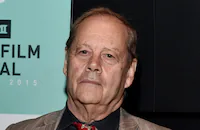Don's Party

Brief Synopsis
Cast & Crew
Bruce Beresford
Kit Taylor
John Hargreaves
Graeme Blundell
Graham Kennedy
Pat Bishop
Film Details
Technical Specs
Synopsis
Don and his wife throw a party to watch the televised returns of Australia's general election. As with all great parties, guests let their guard down, saying and doing things they might regret later.
Director

Bruce Beresford
Cast
Kit Taylor
John Hargreaves
Graeme Blundell
Graham Kennedy
Pat Bishop
Veronica Lang
Ray Barrett
Jeanie Drynan
Harold Hopkins
Candy Raymond
Claire Binney
John Grey Gorton
Crew
Phillip Adams
William Anderson
David Barrow
Desmond Bone
Felix Bryant
Fran Burke
Thomas Evans
Peter Fenton
John Grey Gorton
John Grayling
Peter Ham
Rhoisin Harrison
Graham Irwin
Leos Janacek
Toivo Lember
Judy Lovell
Mike Martorana
Donald M. Mcalpine
Donald M. Mcalpine
Johnny O'keefe
Doug Parkinson
Anna Senior
Lyn Tunbridge
David Williamson
David Williamson
Ross D Wylie
Johnny Young
Film Details
Technical Specs
Articles
Don's Party
David Williamson's play Don's Party became a hit around Australia after its 1971 premiere in Melbourne. Inspired in part by the writer's relationships with his own friends, it traces the shifting loyalties of a group of couples as they gather at Don's house to celebrate the 1969 national elections, at which the Labor Party, which most of them support, is expected to win. As the final results leave the more conservative Liberals in power, the party gets wilder and the haze of liquor exaggerates personal animosities and sexual attractions.
Originally, British director Jack Lee (the 1956 A Town Like Alice) bought the film rights and brought the project to producer Phillip Adams, the man whose sex-charged comedy The Adventures of Barry McKenzie (1972) had reinvigorated the Australian film industry. When he had trouble raising money for the picture, Lee started pushing Williamson to make the comedy broader, arguing that would give it greater box-office appeal. That didn't work for Williamson, however, and Lee was pushed out of the production he had started. Several prominent Australian directors, including Peter Weir, turned the project down, leaving it to Bruce Beresford, who had directed The Adventures of Barry McKenzie.
By that time, the play was four years old, and there were discussions about updating the story to reflect recent changes in the Australian political landscape. Eventually, however, Beresford and Williamson realized that the story of Labor supporters losing an election they expected to win really wouldn't work in any year but 1969, so they kept the period the same. At the same time, they decided to move the action from its original Melbourne setting to Sydney, partly because it would be cheaper to film there. In addition, they felt Sydney was more central to the Australian consciousness, making the film version easier to market around the country. With those changes in place, Adams raised production money from the Australian Film Commission and theatre owners.
Adams originally envisioned casting well-known television actors in all the roles. At the time, Australia had no real film stars of its own, so Adams offered leading roles to well-known actors like Barry Crocker, who had starred for Beresford in Barry McKenzie Holds His Own (1974), Paul Hogan and Graham Kennedy. Hogan turned down the role of womanizer Cooley. Crocker broke his back the day before filming was scheduled to start, so John Hargreaves, who had tried out unsuccessfully to play Cooley, stepped into the title role at the last minute. At least he had had some experience working with Williamson, having appeared in the film version of the playwright's The Removalists (1975). The only TV star to make it into the cast was Kennedy, who felt rather intimidated to be surrounded by stage actors, many of whom, like Hargreaves, had acted in the play previously. Co-star Graeme Blundell, playing against type as the repressed conservative accountant after years of starring as womanizer Alvin Purple in a series of films starting with The Sex Therapist (1973), had actually produced the play's first production, in Melbourne. Beresford appeared on screen in a cameo as a shop owner, and former Liberal Prime Minister John Gorton played himself, even though most of the film's characters were opposed to his government.
The film had a huge impact in Australia, where it did well at the box office and captured Australian Film Institute Awards for Best Actress (Pat Bishop), Best Supporting Actress (Veronica Lang), Director, Screenplay, Editing and Sound. The film remains an essential part of Australian culture. In 1998, the group You Am I included re-enactments of scenes from Don's Party in the video for their hit "What I Don't Know 'bout You." In 2005, many of the original cast, along with Beresford and Adams, reunited to discuss the film in the documentary Crashing the Party: The Making of "Don's Party", a film that actually runs almost an hour longer than the original picture. Williamson wrote a stage sequel, Don Parties On, in 2010. The new play takes the characters through the elections of 2010 and explores the ways in which they have been changed by time.
By Frank Miller
Producer: Phillip Adams
Director: Bruce Beresford
Screenplay: David Williamson
Based on his play
Cinematography: Donald McAlpine
Cast: John Hargreaves (Don Henderson), Jeanie Drynan (Kath Henderson), Pat Bishop (Jenny), Ray Barrett (Mal), Graeme Blundell (Simon), Veronica Lang (Jody), Harold Hopkins (Cooley), Clare Binney (Susan), Bruce Beresford (Bottle Shop Attendant), John Gorton (Himself)

Don's Party
Quotes
Hello, gorgeous! Care for a screw?- Cooley
He used to say "fuck."- Don Henderson
Any particular reason for the change?- Kerry
Yeah, I get more fucks when I say "screw."- Cooley
Trivia
Miscellaneous Notes
Released in United States Winter January 1, 1976
Re-released in United States on Video June 29, 1999
Panavision
c 200 color
c Eastmancolor
8117 feet
rtg BBFC X (British Board of Film Classification)
Released in United States Winter January 1, 1976
Re-released in United States on Video June 29, 1999













